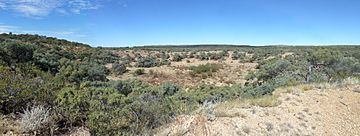Boxhole crater facts for kids

Boxhole meteorite crater, July 2011
|
|
| Impact crater/structure | |
|---|---|
| Confidence | Confirmed |
| Diameter | 170 m (560 ft) |
| Age | 5.4 ± 1.5 ka Holocene |
| Exposed | Yes |
| Drilled | No |
| Location | |
| Coordinates | 22°36′45″S 135°11′43″E / 22.61250°S 135.19528°E |
| Country | Australia |
| State | Northern Territory |
Boxhole is a special kind of hole in the ground called an impact crater. It was made when a space rock, like a meteorite, crashed into Earth. You can find it about 180 kilometers (112 miles) northeast of Alice Springs in the Northern Territory, Australia.
The crater is about 170 meters (558 feet) wide. Scientists believe it was formed around 5,400 years ago, during a time called the Holocene period. You can see the crater clearly on the surface today.
How Was Boxhole Crater Discovered?
The Boxhole crater was first explored by a geologist named Cecil Madigan in 1937. A local worker, Joe Webb, who was a shearer (someone who shears sheep), showed him the crater.
Madigan found pieces of metal that contained nickel. He also found special rocks called iron shale-balls. These were similar to other meteorite pieces found at another crater called Henbury, which is also in Australia.
Boxhole was only the second impact crater ever officially studied in Australia. Later, more searches found even more pieces of the meteorite. One large piece of iron, weighing about 82 kilograms (181 pounds), is now kept in the Natural History Museum in London.


